Uncovering the Hidden Bottleneck: Your Memory Controller Matters

Enthusiasts aiming to maximize performance from their RAM kits often overlook a crucial component in their systems: the memory controller located within the CPU. As more users encounter instability and failure to achieve expected overclock speeds, it becomes evident that the integrated memory controller (IMC) might be the hidden bottleneck in their computer setups.
Understanding the Role of the Memory Controller
The integrated memory controller manages the communication between the processor cores and the system RAM. This component is essential when the CPU performs read and write operations. The IMC oversees not only the speed of these transfers but also the timings involved, including key metrics such as CAS latency, tRCD, and tRP.
When users tighten these timings to enhance performance, they risk reducing the margin of error. This action can lead to data corruption or instability, especially under varying conditions such as high temperatures or low voltage. Additionally, the IMC’s inability to operate faster than a designated speed complicates matters. Faster memory can lead to signal integrity issues, which the IMC cannot adequately sample if the signal is distorted.
Thermal limitations within the CPU further constrain the IMC’s performance, as faster operations would contribute significantly to heat generation. Therefore, even if high-quality memory modules are installed, their potential may remain unrealized if the IMC cannot support those capabilities.
Decoupling Memory and Controller Clocks
As memory speeds continue to escalate, both AMD and Intel allow users to decouple memory and controller clocks. While manufacturers recommend a coupled mode for optimal performance, enthusiasts may choose to experiment with this decoupling to achieve higher speeds that may not be feasible otherwise.
On Intel platforms, users can run memory at a 1:2 (Gear Mode 2) or even 1:4 (Gear Mode 4) ratio with the controller. In contrast, AMD systems typically support only a 1:2 ratio. This decoupling introduces latency, as the controller operates at a fraction of the RAM’s speed. For instance, the cutoff point for a 1:1 ratio on AMD AM5 CPUs exceeds 6400 MT/s, while modern Intel chips range from 3600 MT/s up to 9000 MT/s before activating 1:4 mode.
Although latency typically hampers performance, there are instances where pushing past certain thresholds can yield benefits. For example, DDR5 memory operating above 8000 MT/s on AMD CPUs has been known to outperform configurations running at 6400 MT/s without decoupling. However, this advantage largely depends on the specific workloads, with tasks requiring extensive data processing, such as video editing, potentially suffering from increased latency.
The Impact of CPU Binning on Performance
CPU binning is the practice of categorizing processors based on their capabilities, including power consumption, frequency, and leakage. This process results in high-performance models being branded as top-of-the-line products. It is important to note that even CPUs sharing the same SKU can exhibit variations in performance, particularly concerning the integrated memory controller.
Some documented instances of this phenomenon include Intel’s 14th-gen i7 and i9 CPUs, where performance varies based on the specific die. Similarly, certain SKUs of AMD’s Ryzen 7 7800X3D can support 6400 MT/s at a 1:1 ratio, while others do not.
Despite the impressive specifications of DDR5 memory, achieving high-speed overclocks may prove challenging due to IMC limitations. Users running premium memory kits might find themselves unable to reach the speeds they anticipated. To mitigate these challenges, increasing the System Agent voltage and investing in a high-end motherboard can help, but these solutions only address the issue to a limited extent.
Ultimately, while CPU manufacturer-recommended speeds suffice for many users, those who seek to push their memory to the limit must contend with the potential of the IMC acting as a performance bottleneck. Understanding this component’s role is vital for anyone serious about optimizing their system’s capabilities.






